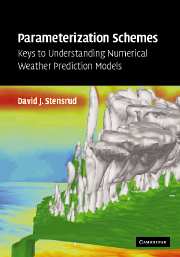Book contents
- Frontmatter
- Contents
- Preface
- List of principal symbols and abbreviations
- 1 Why study parameterization schemes?
- 2 Land surface–atmosphere parameterizations
- 3 Soil–vegetation–atmosphere parameterizations
- 4 Water–atmosphere parameterizations
- 5 Planetary boundary layer and turbulence parameterizations
- 6 Convective parameterizations
- 7 Microphysics parameterizations
- 8 Radiation parameterizations
- 9 Cloud cover and cloudy-sky radiation parameterizations
- 10 Orographic drag parameterizations
- 11 Thoughts on the future
- References
- Index
3 - Soil–vegetation–atmosphere parameterizations
Published online by Cambridge University Press: 05 September 2013
- Frontmatter
- Contents
- Preface
- List of principal symbols and abbreviations
- 1 Why study parameterization schemes?
- 2 Land surface–atmosphere parameterizations
- 3 Soil–vegetation–atmosphere parameterizations
- 4 Water–atmosphere parameterizations
- 5 Planetary boundary layer and turbulence parameterizations
- 6 Convective parameterizations
- 7 Microphysics parameterizations
- 8 Radiation parameterizations
- 9 Cloud cover and cloudy-sky radiation parameterizations
- 10 Orographic drag parameterizations
- 11 Thoughts on the future
- References
- Index
Summary
Introduction
Evolution teaches us that organisms must come to terms with their environment in order to grow and reproduce successfully. This suggests that many, if not all, successful organisms have strategies that allow them to adapt to changing environmental conditions. Unfortunately, when an organism interacts with its environment, the physical processes are rarely simple and the physiological mechanisms often are poorly understood. This is the challenge one faces when trying to incorporate vegetation into numerical models.
The atmosphere and vegetation interact in a number of different ways, and many of these need to be parameterized. The main five ways in which they interact are via the biophysical control of evapotranspiration, momentum transfer, soil moisture availability, radiation, and insulation (Sellers et al. 1986). The discussion of soil–vegetation–atmosphere parameterizations is organized around these five interaction types.
Biophysical control of evapotranspiration
Plants use photosynthetically active radiation, part of shortwave radiative energy, to combine water and carbon dioxide (CO2) into sugars and other organic compounds. Thus, plants must allow for the transfer of CO2 from the atmosphere to the cellular sites of photosynthesis. By doing so, plants expose their saturated tissues to the atmosphere and water loss occurs. Plants regulate the amount of CO2 exchanged, and therefore regulate water loss, by means of valve-like structures on the leaf surface called stomates. Some plants have stomates on both sides of the leaf; others on only one side.
- Type
- Chapter
- Information
- Parameterization SchemesKeys to Understanding Numerical Weather Prediction Models, pp. 63 - 119Publisher: Cambridge University PressPrint publication year: 2007



